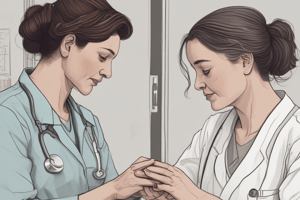Podcast
Questions and Answers
What is the purpose of introducing yourself by name when communicating?
What is the purpose of introducing yourself by name when communicating?
- To make the interaction more personal (correct)
- To intimidate the other person
- To ensure the other person listens
- To establish a hierarchy
Which phrase should be avoided to prevent communication barriers?
Which phrase should be avoided to prevent communication barriers?
- You people need to understand (correct)
- Let me help you with that
- What can I do for you?
- I understand your concern
How should an officer respond when a person's request seems unrealistic?
How should an officer respond when a person's request seems unrealistic?
- Ignore the request altogether
- Focus on what cannot be done
- Reject the request outright
- Redirect the focus to what can be done (correct)
Which characteristic is NOT typically associated with professionalism?
Which characteristic is NOT typically associated with professionalism?
What is meant by courtesy in professional conduct?
What is meant by courtesy in professional conduct?
Which of the following behaviors exemplifies good professional conduct?
Which of the following behaviors exemplifies good professional conduct?
Why is maintaining a professional demeanor important for officers?
Why is maintaining a professional demeanor important for officers?
Which of the following is a characteristic of professionalism?
Which of the following is a characteristic of professionalism?
What impact does a courteous approach have on public interactions?
What impact does a courteous approach have on public interactions?
What is the first non-verbal message you convey upon arriving at a scene?
What is the first non-verbal message you convey upon arriving at a scene?
Which action demonstrates respect for your job and the community?
Which action demonstrates respect for your job and the community?
Why is it important to evaluate both verbal and non-verbal communication?
Why is it important to evaluate both verbal and non-verbal communication?
What might indicate a discrepancy in communication during a traffic stop?
What might indicate a discrepancy in communication during a traffic stop?
How can one make a victim more comfortable during an interaction?
How can one make a victim more comfortable during an interaction?
What is non-verbal communication?
What is non-verbal communication?
What does maintaining a clean and pressed uniform signify?
What does maintaining a clean and pressed uniform signify?
What does a tenant's sweating and heavy breathing suggest despite verbal reassurance?
What does a tenant's sweating and heavy breathing suggest despite verbal reassurance?
What role should one consider to determine a suitable professional response?
What role should one consider to determine a suitable professional response?
What is the goal of understanding non-verbal cues?
What is the goal of understanding non-verbal cues?
What is an effective use of non-verbal communication in a noisy environment?
What is an effective use of non-verbal communication in a noisy environment?
How can non-verbal communication complement a verbal message?
How can non-verbal communication complement a verbal message?
What should you do when communicating with someone who is hearing impaired?
What should you do when communicating with someone who is hearing impaired?
What does self-awareness contribute to in difficult situations?
What does self-awareness contribute to in difficult situations?
Which of the following best describes procedural justice in communication?
Which of the following best describes procedural justice in communication?
Why is it important to assess implicit biases in communication?
Why is it important to assess implicit biases in communication?
What does mutual gaze typically indicate during a conversation?
What does mutual gaze typically indicate during a conversation?
Which of the following can cause a break in gaze?
Which of the following can cause a break in gaze?
Why is it important to evaluate both verbal and non-verbal communication?
Why is it important to evaluate both verbal and non-verbal communication?
What can an absence of eye contact typically indicate?
What can an absence of eye contact typically indicate?
In conflict situations, what should be prioritized for effective resolution?
In conflict situations, what should be prioritized for effective resolution?
Which of the following is NOT a barrier to communication?
Which of the following is NOT a barrier to communication?
What aspect of communication should be considered to fully understand a person's message?
What aspect of communication should be considered to fully understand a person's message?
How can personality affect communication?
How can personality affect communication?
What does cultural norm influence in communication?
What does cultural norm influence in communication?
What is one potential outcome of misinterpreting non-verbal communication during an interaction?
What is one potential outcome of misinterpreting non-verbal communication during an interaction?
What is a primary goal of de-escalation techniques?
What is a primary goal of de-escalation techniques?
What is a possible outcome when conflicts cannot be managed peacefully?
What is a possible outcome when conflicts cannot be managed peacefully?
Why is it important for law enforcement officers to display professional behavior?
Why is it important for law enforcement officers to display professional behavior?
How can partnerships between law enforcement and communities affect safety?
How can partnerships between law enforcement and communities affect safety?
What might impact a community member's trust in law enforcement officers?
What might impact a community member's trust in law enforcement officers?
What should officers know about their authority?
What should officers know about their authority?
Which of the following is NOT an expected behavior for law enforcement officers in the community?
Which of the following is NOT an expected behavior for law enforcement officers in the community?
What does community refer to in the context of law enforcement?
What does community refer to in the context of law enforcement?
Which of the following describes a potential effect of professional interactions with the community?
Which of the following describes a potential effect of professional interactions with the community?
Why might an officer encounter individuals who are afraid of law enforcement?
Why might an officer encounter individuals who are afraid of law enforcement?
Flashcards are hidden until you start studying
Study Notes
Role of Empathy in Effective Communication
- Empathy enhances the understanding of others' feelings, facilitating better interactions.
- It allows for a more meaningful connection, particularly in stressful situations like domestic disturbances.
- By recognizing non-verbal cues, such as body language and facial expressions, empathy aids in accurate assessment of situations.
Courtesy in Professional Conduct
- Courtesy exemplifies respect in interactions, crucial for law enforcement officers.
- Introduce yourself and use names to build rapport while maintaining professional demeanor.
- Avoid divisive language or tones, such as "obviously" or "you people," which can create barriers.
- Focus on feasible actions when addressing unrealistic requests to encourage collaboration.
Professionalism
- Defined by characteristics like integrity, fairness, and compassion, which contribute to effective communication.
- Maintaining personal appearance and hygiene reflects respect for the role and community.
- A positive self-image influences first impressions and can make individuals feel safer and more comfortable during interactions.
Verbal and Non-verbal Communication
- Understanding both verbal and non-verbal cues is critical for appropriate responses.
- Mutual gaze is vital in creating rapport and encouraging communication.
- A break in eye contact may indicate various emotional states; assumptions should not be made quickly.
Conflict Resolution and De-escalation
- Skills in conflict resolution help regain control in tense situations, promoting dialogue and mediation.
- Recognize the limits of your skills and authority when enforcing laws or resolving conflicts.
- Effective communication can diffuse potentially volatile situations.
Community Interaction
- Building partnerships with the community enhances security and trust.
- Officers must demonstrate fairness, compassion, and professionalism in all interactions.
- Employ non-verbal cues for clarity when verbal communication is ineffective.
Awareness of Implicit Bias and Self-Reflection
- Regularly assess potential biases that may affect interactions.
- Self-awareness improves emotional intelligence, aiding in control of reactions in various situations.
Procedural Justice
- Procedural justice fosters community relationships by ensuring transparency and respect.
- Key elements include explaining actions, allowing for open dialogue, and maintaining a respectful demeanor during interactions.
Studying That Suits You
Use AI to generate personalized quizzes and flashcards to suit your learning preferences.




